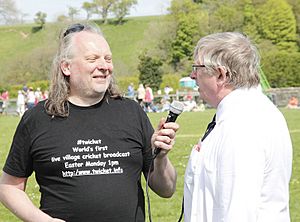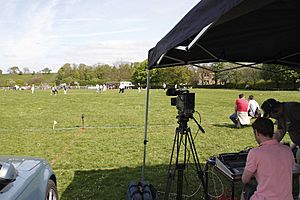Twicket facts for kids

Twicket was a special village cricket match. It was shown live on the Internet so people could watch it from anywhere in the world. This event happened on Easter Monday, April 25, 2011. The people who organized it wanted to show how useful very fast internet can be. They believed fast internet helps local groups share their events online. The organizers said Twicket was the first village cricket match ever to be streamed live on the internet.
The name "Twicket" is a made-up word. It combines "Tw" from Twitter and "icket" from Cricket.
Many news outlets reported on Twicket. It was featured on BBC television news and BBC Radio London. Both The Guardian and Metro newspapers wrote about it. Famous people like Stephen Fry, BBC's Rory Cellan-Jones, and BBC cricket expert Jonathan Agnew also mentioned Twicket on Twitter.
Contents
How Twicket Started
John Popham, who gives expert advice to companies, decided to stream Twicket online. He got the idea from two comments he saw on Twitter. First, Dan Slee said he wanted to see news about his local village cricket team on Twitter.
Then, Chris Conder mentioned she was testing a new, very fast internet connection. This connection could upload data as quickly as it downloaded it. Chris lived in Wray, a village in Lancashire, England. Lancaster University installed this special internet in Wray. Wray was one of only three villages in the UK with such a fast, local internet network.
Chris told John that a special cricket match was coming up in Wray. It was part of the village’s yearly Scarecrow Festival. The match was between Wray and a team called "The Rest of the World."
John Popham explained his idea: "I'm sure we can do this because the village internet has a super-fast upload speed," he said. "It's a bit of fun, but it also has a serious goal. The serious part is to show that it can be done. It is possible to broadcast events like this live using fairly cheap equipment and a good internet connection. It will also show how important good internet is in the countryside. We need fast upload connections if we want more people to create their own online videos or articles."
The Cricket Match
The match followed the Twenty20 format, meaning each team batted for 20 overs. There was a special rule: any player who scored 20 runs had to stop batting. Wray won a coin toss and decided to bowl first. After 20 overs, The Rest of the World had scored 69 runs and had 5 players out. This meant Wray needed 70 runs to win.
Wray managed to score the runs they needed. They won the game in their eleventh over by hitting a six. Wray won the match with 8 players still not out.
After the cricket match, there was a tug-of-war contest. This was also shown live online. The Rest of the World team won the tug-of-war. Interviews with some of the cricket players and other people were also streamed on the internet.
How Twicket Was Broadcast
The event was streamed live on a website called Bambuser. A company from Birmingham called Aquila TV provided technical help. Aquila used special cameras for the broadcast. At one point, 2,733 people were watching the live stream at the same time.
Watching and Listening Online
A separate audio-only commentary was also broadcast online by Radio Youthology. Radio Youthology is also from Birmingham. About 1,780 people listened to their commentary. This was Radio Youthology's biggest audience ever.
Twicket in the News
A news team from BBC North West television also came to the match. They made a short film about it. This film was shown on TV the same evening.
The special word used for the event on Twitter was #twicket. This word became a popular topic on Twitter just before the match ended.
Images for kids



